
Renfe Cercanias - Regional commuter trains
For a full scale picture, please click on the picture shown !
Cercanías is the name given to the commuter rail systems of Spain's major metropolitan areas. In the Valencian Community,
the term is replaced by Rodalia, while the designation Aldiriak is used in the Basque Country. In Catalonia, it is
commonly known as Rodalies de Catalunya
Aldiriak - The Cercanias trains around Bilbao in the Basque area
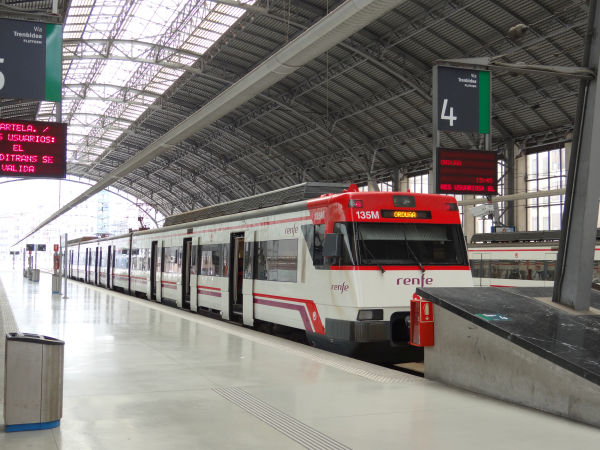
In the Basque area around Bilbao the commuter trains are not usually called by the generic name Cercancias Bilbao as the case would be
in most parts of the country, but with the Basque words Bilboko Aldiriak. Nevertheless the trains are quite normal Renfe commuter trains.
This one is a class 447 electric multiple unit of the Aldiriak service from Bilbao to Orduña.
Picture from Bilbao Abando station 4.5.2013 by Ilkka Siissalo.
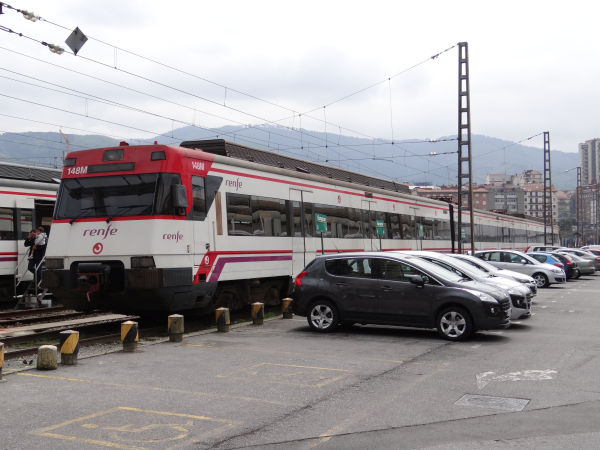
Two other class 447 Aldiriak commuter trains waiting outside the Bilbao Abando station.
Picture from Bilbao Abando station 4.5.2013 by Ilkka Siissalo.
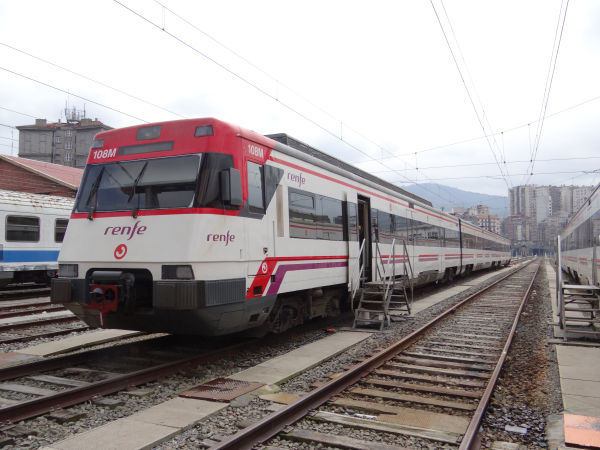
A class 447 Aldiriak commuter train undergoing cleaning and waiting for its next use.
Picture from Bilbao Abando station 4.5.2013 by Ilkka Siissalo.
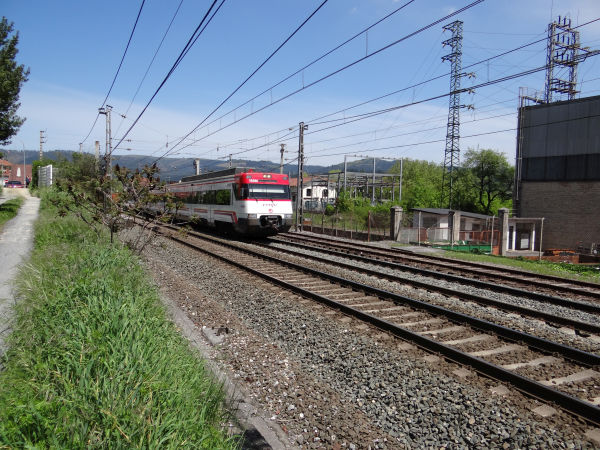
Another class 447 Aldiriak commuter train underway, just reaching the train stop of Amurrio.
Picture from Amurrio near Bilbao 5.5.2013 by Ilkka Siissalo.
Rodalies de Catalunya - Catalan government's trains
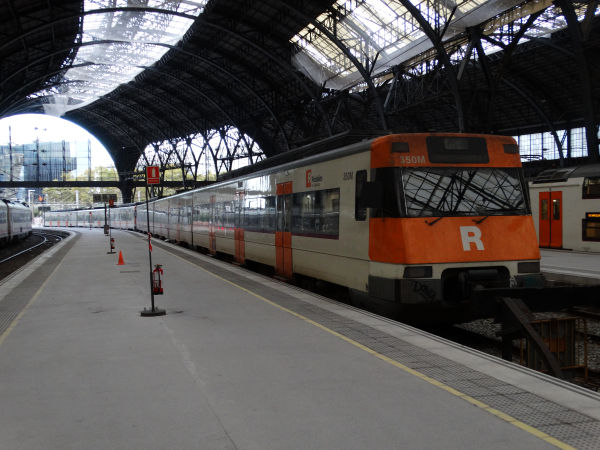
The Barcelona metropolitan area's pendeling trains or Rodalies de Catalunya are trains of the Catalan Government, but the operator
is still the Spanish state railways Renfe. But the Rodalies trains have their own orange livery. This one is a class 447 unit. They
were built by a consortium of companies including CAF, Alstom, Siemens, ABB, and Adtranz since 1993. Top speed of the train is
120 km/h and it can take up to 702 passengers.
Picture from Barcelona Franca station 8.11.2018 by Ilkka Siissalo.
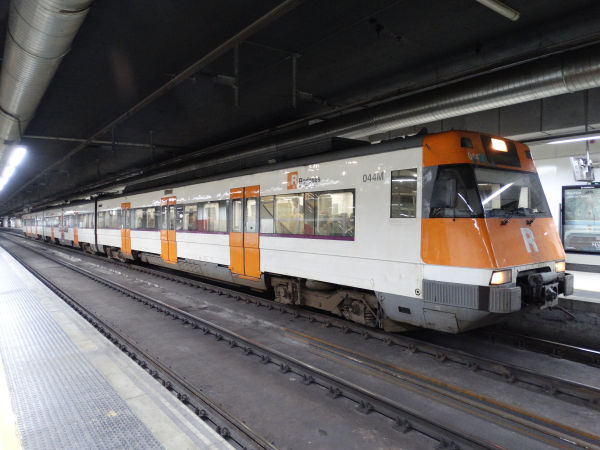
Whoo-hoo!! A Rodalies de Catalunya class 447 train clean, almost without graffiti. A real rarity!!
Picture from Barcelona Sants station 8.11.2018 by Ilkka Siissalo.
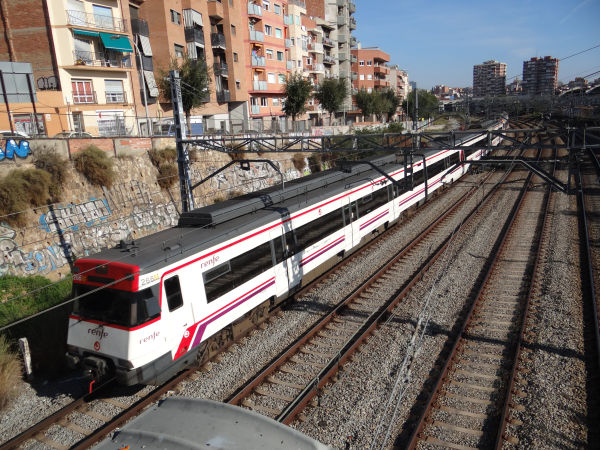
A Rodalies train consisting of two class 447 electric multiple units which are still in their original Renfe livery.
Picture from close to the Santa Eulalia station in Barcelona 14.11.2015 by Ilkka Siissalo.

The class 450/451 double decker train of the Rodalies service was built by Alstom and CAF from 1988 on. 24 trainsets were made.
It can take up to 1844 passengers and they are used on the busiest routes in the Rodalies network, here on line R2. The train
has a power rating of 2960 kW and a top speed of 140 km/h.
Picture from Barcelona Franca station 8.11.2018 by Ilkka Siissalo.
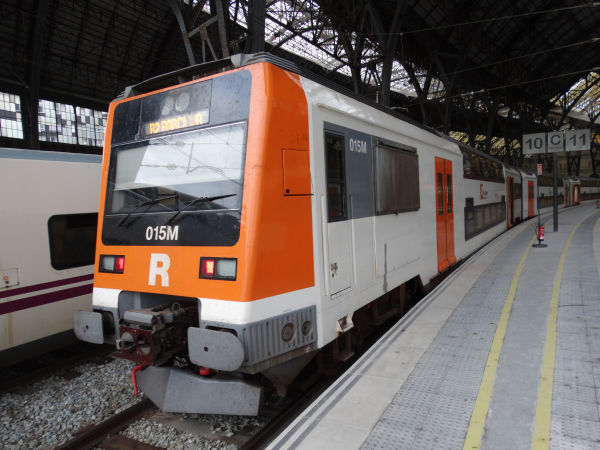
Another graffiti-free class 450/451 doubledecker Rodalies train.
Picture from Barcelona Franca station 8.11.2018 by Ilkka Siissalo.
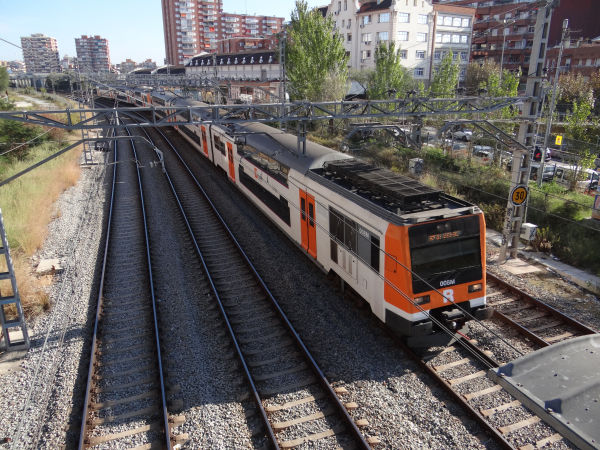
A long Rodalies train consisting of one class 450 and one class 451 (they differ in their length) doubledecker multiple units.
Picture from close to the Santa Eulalia station in Barcelona 14.11.2015 by Ilkka Siissalo.

Same train as in the picture above, but seen from behind.
Picture from close to the Santa Eulalia station in Barcelona 14.11.2015 by Ilkka Siissalo.
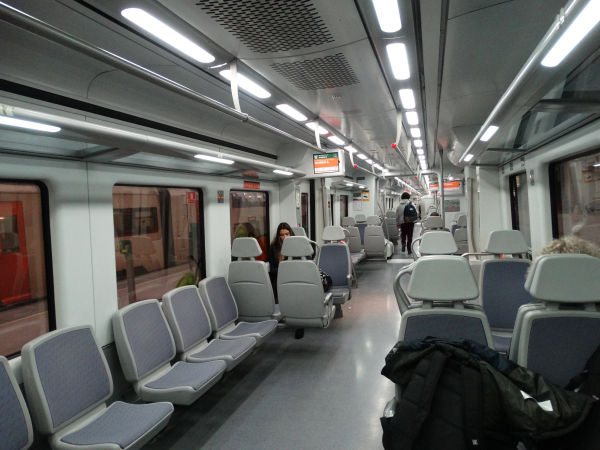
This is an inside view of a Civia train of the Rodalies de Catalunya service. The Civia trains were built by CAF, Siemens and Alstom
since 2003 and they are presently the newest Rodalies trains.
Picture from Barcelona Franca station 8.11.2018 by Ilkka Siissalo.

The same Civia train as above, but seen from outside. Most local trains in Barcelona are today really badly smeared with graffiti shit.
Picture from Barcelona Sants station 8.11.2018 by Ilkka Siissalo.
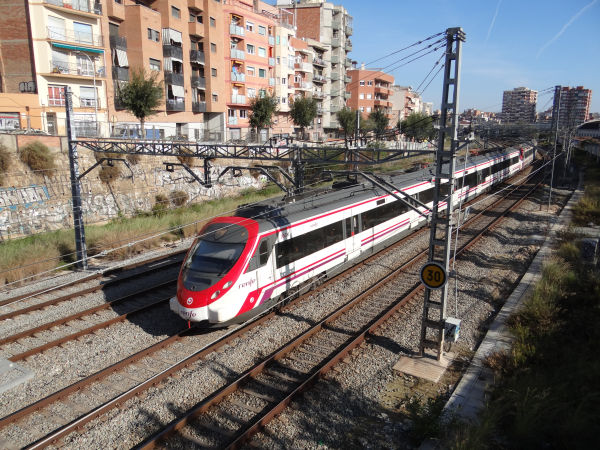
A Rodalies train consisting of two Civia train units, the first of which was still then in 2015 in the "generic" Renfe colours instead
of the Catalan government's orange Rodalies livery. In those days the graffiti problem was still not yet so bad.
Picture from close to the Santa Eulalia station in Barcelona 14.11.2015 by Ilkka Siissalo.
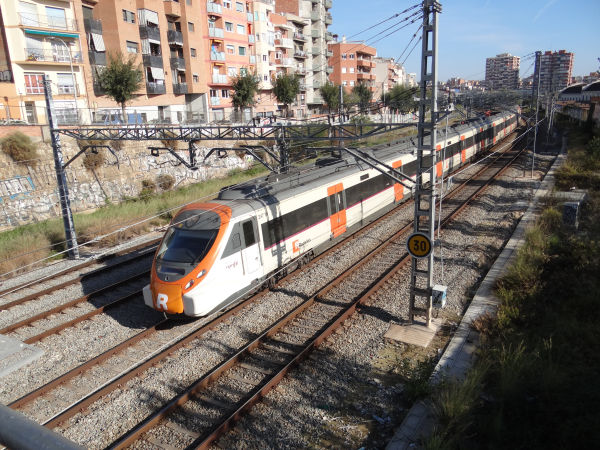
Another Civia train seen at the same place as the train above, but this one has already the newer Catalan orange painting.
Picture from close to the Santa Eulalia station in Barcelona 14.11.2015 by Ilkka Siissalo.
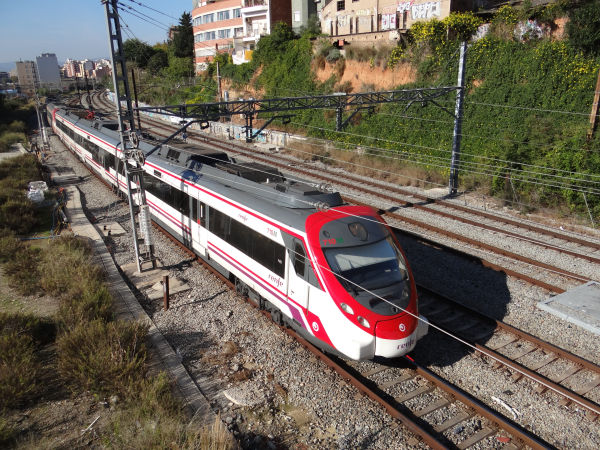
Yet another Rodalies train consisting of two CAF Civia units. This one is still in Renfe's original livery.
Picture from close to the Santa Eulalia station in Barcelona 14.11.2015 by Ilkka Siissalo.
Cercanias Santander
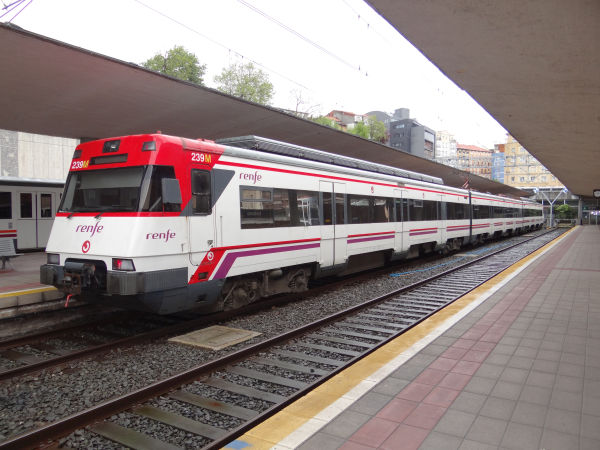
The Cercanias Santander local commuter services around the city of Santander use the very standard Renfe class 447 trains with no
specific markings for the Santander region.
Picture from Santander station 1.5.2013 by Ilkka Siissalo.
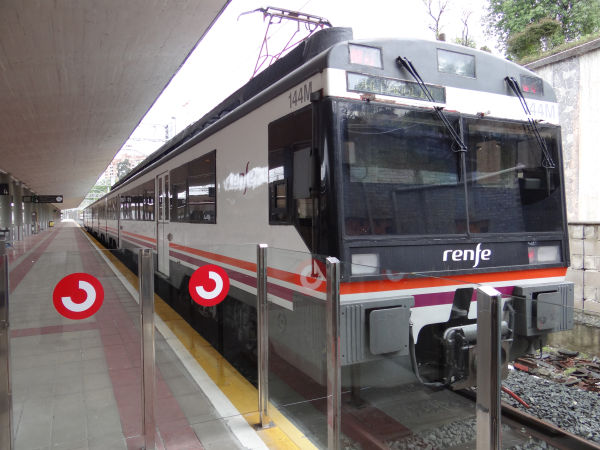
This is a class 470 train used here for the Cercanias Santander services. The same type is used in other parts of the country as a
Renfe Media Distancia train for regional express services.
Picture from Santander station 1.5.2013 by Ilkka Siissalo.
Portuguese CP trains in Spain
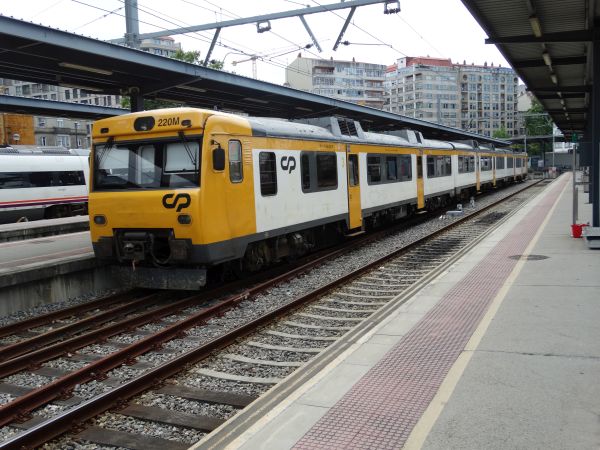
Is this Spanish or Portuguese? Well... The answer is yes. :-) This is an old class 592 diesel multiple unit, built for the Spanish Renfe.
But the Portuguese national railways CP has rented a number of them with long term agreements and is using them on several non-electrified
routes such as the line following the Douro river. Here we see one of the class 592 back in its home country Spain, but carrying still
Portuguese CP's colours. This picture is from the city of Vigo, which is located in the very north of Spain and quite close to the Portuguese
border. This one was actually running a short distance train service from Vigo across the border to Portugal.
Picture from Vigo Guixar station 16.6.2023 by Ilkka Siissalo.
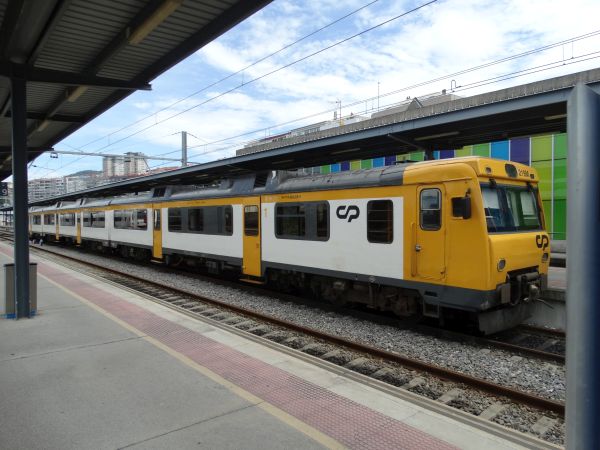
Another picture of the Spanish-Portuguese class 592 train. Wikipedia tells us that class 592 is a class of diesel multiple unit trains built
by Macosa and Ateinsa for some Renfe Cercanías commuter railway networks in Spain, as well as various regional services in Spain and Portugal.
The first units entered service in 1981.
Picture from Vigo Guixar station 16.6.2023 by Ilkka Siissalo.

